How we created the Dream Service Desk
Sometimes you can hear the phrase "the older the product, the more functional it is." In the age of modern technology, the far-reaching web, and the SaaS model, this statement almost doesn't work. The key to successful development is constant monitoring of the market, tracking customer requests and requirements, readiness to hear an important comment today, drag it into the backlog in the evening, and start developing tomorrow. This is how we work on the HubEx project - a service management system for equipment. We have an excellent and diverse team of engineers, and we could develop a dating service, an exciting mobile game, a time management system or the most convenient todo list in the world. These products would quickly shoot in the market, and we could rest on our laurels. But our team, immigrants from an engineering company, knows an area where a lot of pain, problems and difficulties - this is a service. We think that each of you has experienced some of these pains. So, you need to go where they are waiting for us. Well we hope to be waiting :-)
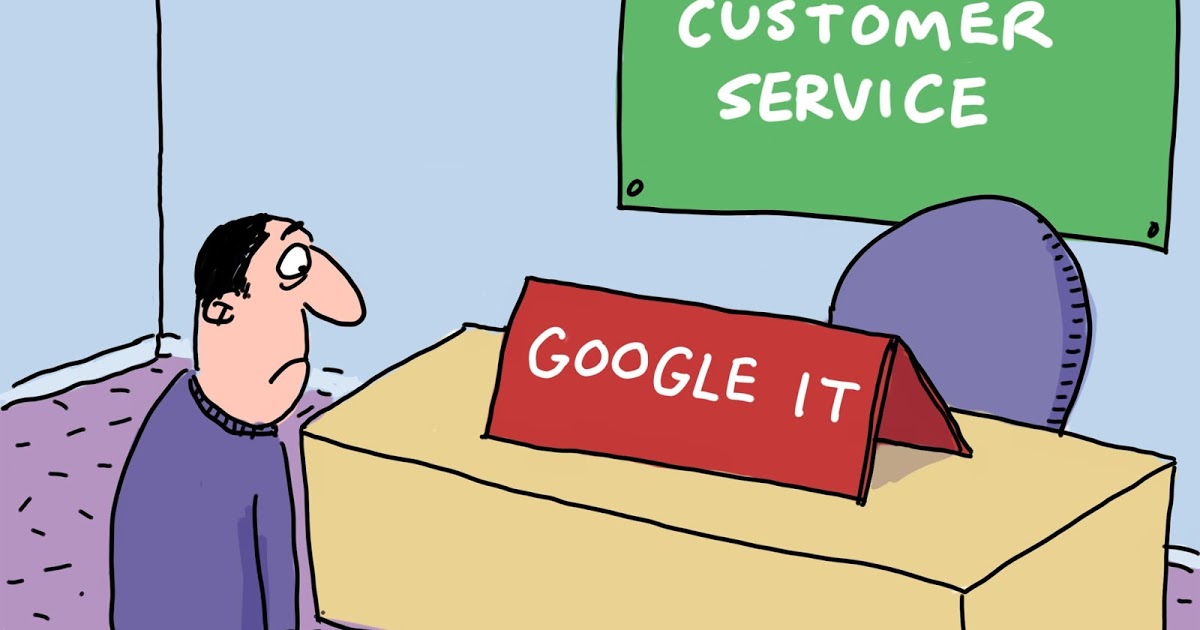
Equipment maintenance for the majority is service centers where phones are saved from encounters with asphalt and puddles, and laptops - from tea and juice. But we are on Habré, and there are those who service equipment of all types:
These listed categories work in different ways, and they all know that there is an ideal scheme: incident - ticket - work - delivery and acceptance of work - closed ticket - KPI - premium (payment). But most often this chain looks like this: AAAAA! - What? - Breakdown! - What? - We can’t work, this simple one is your fault! Urgently! Important! - Pancake. We are working. - What is the status of the repair? And now? - Done, close the ticket. - Oh thank you. - Close the ticket. - And yes, I forgot. - Close the ticket.
Tired of reading, I want to test with my hands, use and criticize your service! If so, sign up for the Hubs and we are ready to work with you.
Why it happens?

Source . Garage Brothers do not use HubEx. But in vain!
Of course, we do not undertake to say now that we created software that did not exist before. There are many equipment maintenance management systems, Service Desk, industry-specific ERPs, etc. on the market. We have come across similar software more than once, but we didn’t like it: the interface, the lack of a client panel, a mobile version, the use of an outdated stack and expensive DBMS. And when a developer doesn’t like something very much, he will certainly create his own. The product itself came out of a real large engineering company, i.e. we ourselves are none other than market representatives. Therefore, we know exactly the pains of service and warranty services and take them into account when developing each new product function for all business sectors.
While we are at the stage of a technological startup, and we are actively continuing to develop and develop the product, but now HubEx users can get a convenient and functional tool. But we will not refuse criticism either - that is why we came to Habr.
There are additional important tasks that HubEx can solve.
The main advantage of our system is the constructor. In fact, we can customize the platform for each individual client for its clear tasks and it will not be repeated. In general, platforming is almost a new reality for enterprise software: the client receives a fully customized version for the cost of renting a conventional solution without the problems of scaling, configuration and management.
Another advantage is the setup of the application life cycle. Each company can set up stages and statuses of applications for each type of application in a few clicks, which will lead to the structuring of information and the generation of detailed reports. Flexible platform settings give +100 to convenience, speed and, most importantly, to transparency of actions and processes.
Inside a HubEx, a company can actually create an electronic equipment passport. You can attach any documentation to your passport, be it a file, video, picture, and so on. There you can specify the warranty period and apply FAQ with frequent problems that the equipment owners themselves can solve: this will increase loyalty and reduce the number of service calls, which will free up time for a high-quality solution to more complex problems.
To get acquainted with HubEx, it is best to leave a request on the site - we will gladly process each and help you figure it out if necessary. “Feeling” it live is quite pleasant and interesting from the point of view of the software structure: user interface, administrator interface, mobile version. But if you suddenly find it more convenient to read, we have prepared for you a brief overview of the main entities and mechanisms.
Application is the main essence of HubEx. You can create any type of application (regular, emergency, warranty, planned, etc.), configure a template or several templates for quick application processing. Inside it, the object is set, the address of its location (with a map), the type of work, the criticality (set in the directory), the deadline, the contractor. You can add a description to the application, attach files. The application fixes the time of the start of execution and completion, thus, the responsibility of each employee becomes quite transparent. You can also set estimated labor costs and the estimated cost of work on the application.
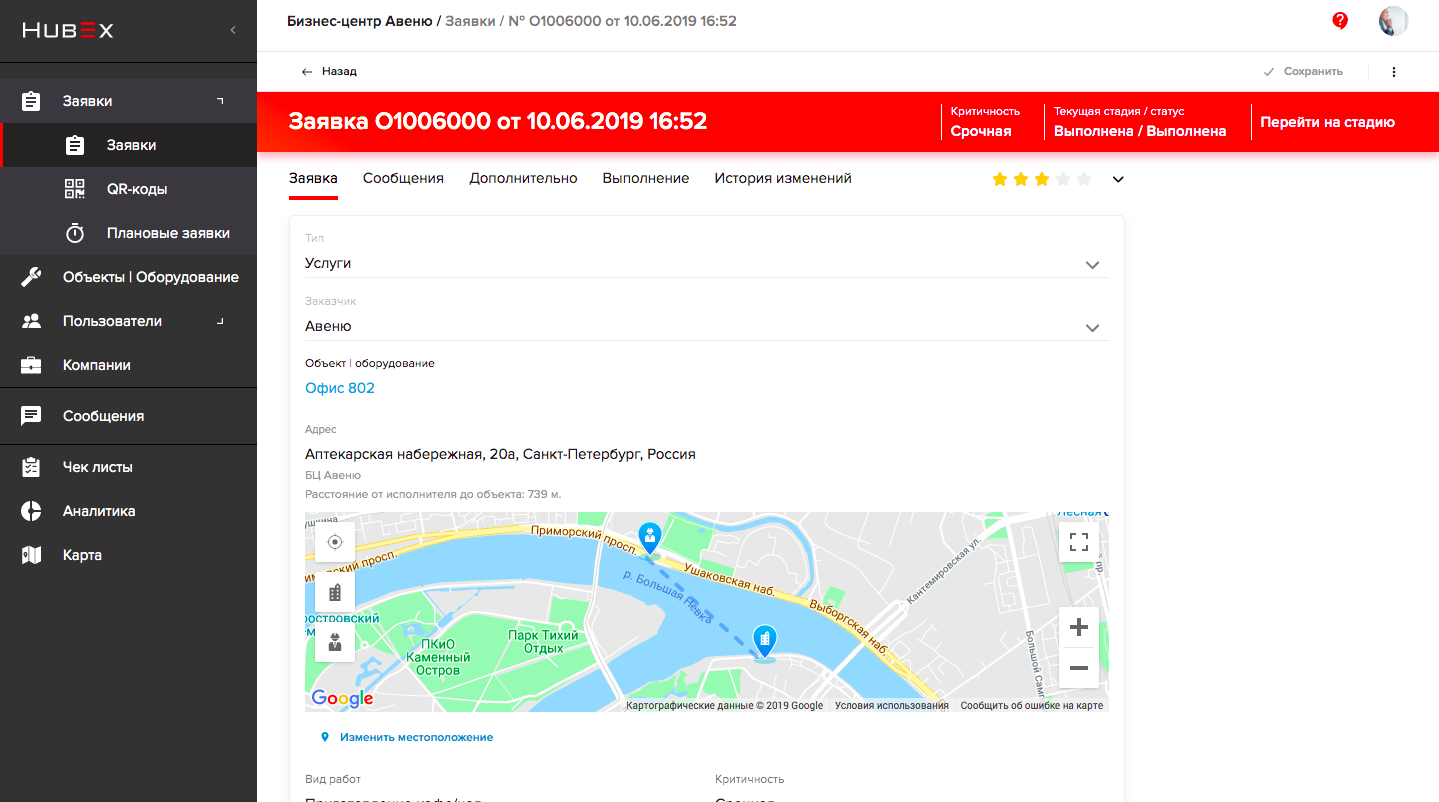
Application Creation Form

Ability to create application stages based on company requirements
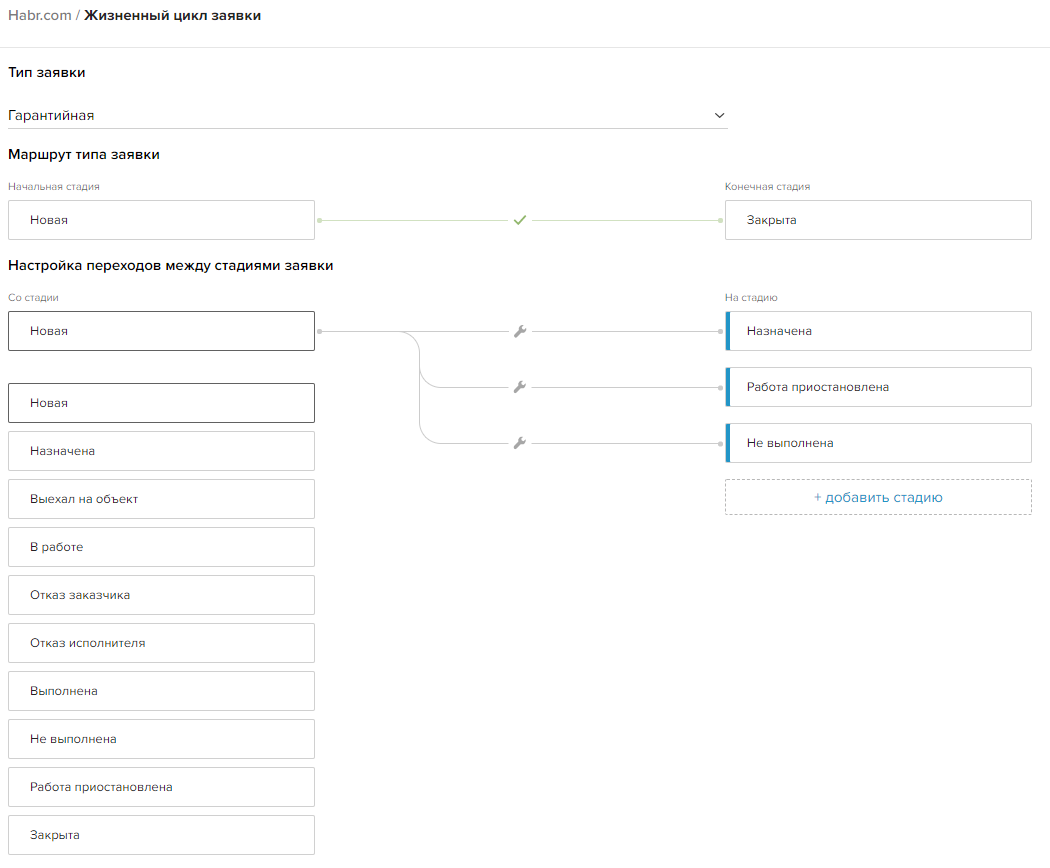
Constructor of transitions between the stages of the application, within which you can prescribe the stages, relationships, conditions. A schematic description of such a “route” is similar to the design of a business process, and can be used for a variety of purposes.
An object is attached to each application (equipment, territory, etc.). An object can be any entity that is subject to servicing by your company. When creating an object, its photo is set, attributes, files, contacts of the person responsible, types of work and check lists for specific equipment are attached. For example, if you need to diagnose a car, the checklist will include attributes listing important components, assemblies, and steps for checking and diagnosing. In the course of work, the master will check each item and will not miss anything.
By the way, you can quickly apply by scanning the QR code (if the equipment was marked by the manufacturer or service) - this is convenient, fast and as productive as possible.
The employee’s card allows you to add maximum information about the person in charge: his name, contact information, type (it is especially interesting that you can have a customer as an employee and give him access to HubEx with limited rights), company, role (with rights). In the additional tab, the qualification of the employee is added, from which it is immediately obvious what kind of work and on what objects the master or engineer can perform. Also, an employee (customer) can be banned, for which it is enough to switch the “Ban” button in the “Other” tab - after that the HubEx functions will become inaccessible for the employee. It’s a very convenient function for service providers, when a quick response to a violation can be vital for a business.

Employee passport
As we said above, in addition to the HubEx interface, you can create checklists, inside which you can write attributes - that is, items that need to be checked as part of working with each type of equipment.
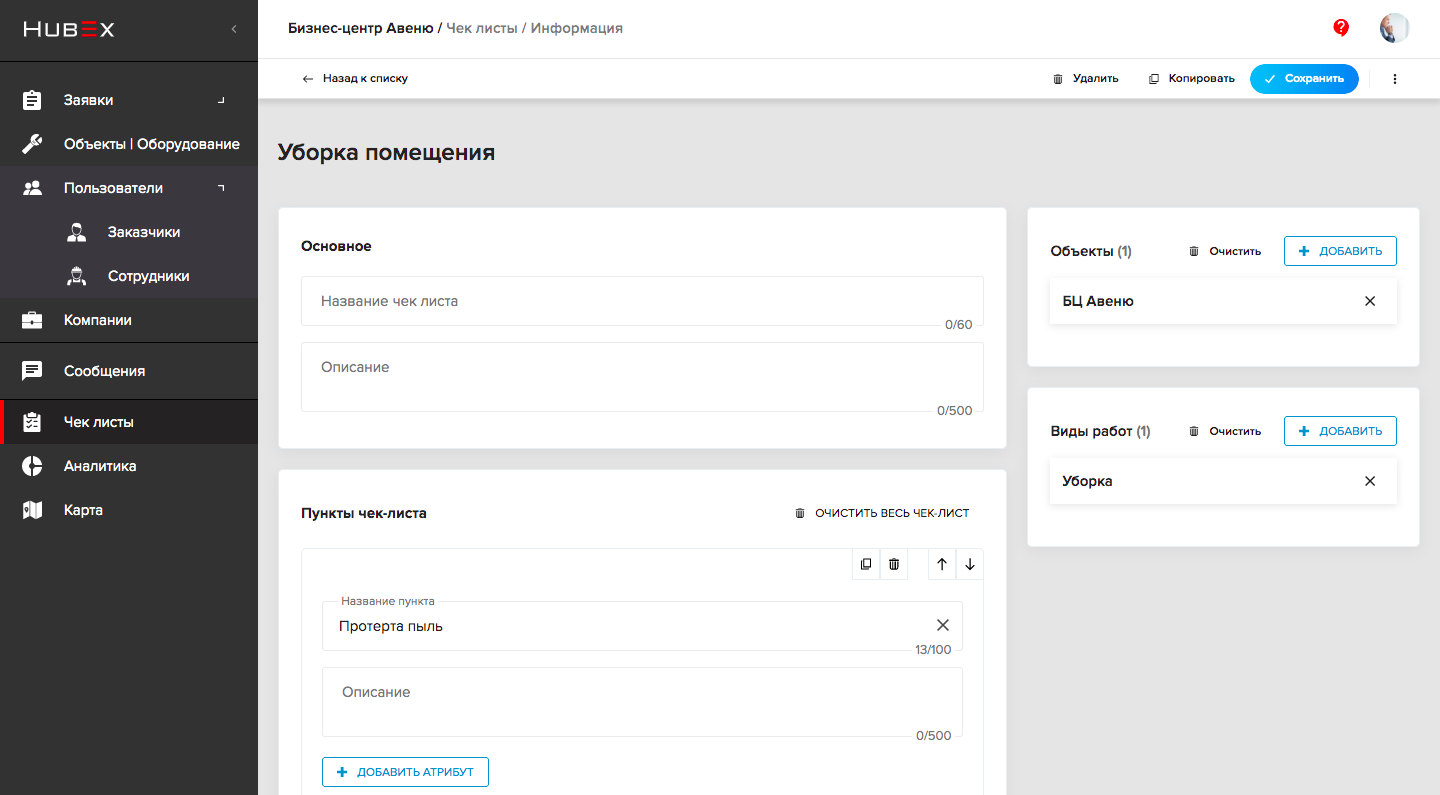
Based on the results of work, a dashboard with analytics is formed inside the HubEx system, where the achieved values and indicators are displayed in the form of tables and graphs. In the dashboard, you can view statistics on the stages of applications, expiration, the number of applications by companies and individual engineers and craftsmen.

Analytical Reports
Repair, maintenance and service is not a one-time process, but a repetitive task, which, in addition to the technical function, carries a commercial burden. And, as you know, there is an unspoken law: if something happened more than two times, automate it. So we created in HubEx automatic creation of planned orders. For a ready application template, a schedule for its automatic repetition with flexible settings is set: frequency, repetition interval during the day (reminder), number of repetitions, days of the week for creating orders, etc. In fact, the setting can be any, including tied to the time before the start of work, for which it is necessary to create an application. The functionality turned out to be in demand both by service and management companies (for routine maintenance), and for companies of different groups - from cleaning and auto center to system integrators, etc. Thus, service engineers can notify the customer about the next service, and managers can sell the services.

Good service is not just operational or professional engineering staff, it is primarily mobility, the ability to quickly go to the client and begin to solve his problem. Therefore, without an adaptive application, by no means, but better, of course, a mobile application.
The mobile version of HubEx is two applications for the iOS and Android platforms.
HubEx for customer service is a working application for service employees in which they can create objects, keep track of equipment, see the status of work on the application, keep correspondence with dispatchers and the necessary colleagues, communicate with the customer directly, coordinate the cost of the work, evaluate their quality.
To receive and mark an object using a mobile application, just point a mobile phone at it and photograph a QR code. Then, in a convenient on-screen form, the remaining parameters are entered: the company associated with the equipment, description, photo, type, class, address and other necessary or custom attributes. Of course, this is a very convenient feature for mobile services, craftsmen and engineers on the road, outsourcing companies. Also in the application of the engineer it is visible precisely his applications and applications for approval. And of course, the program sends users push notifications with which you will not miss a single event in the system.
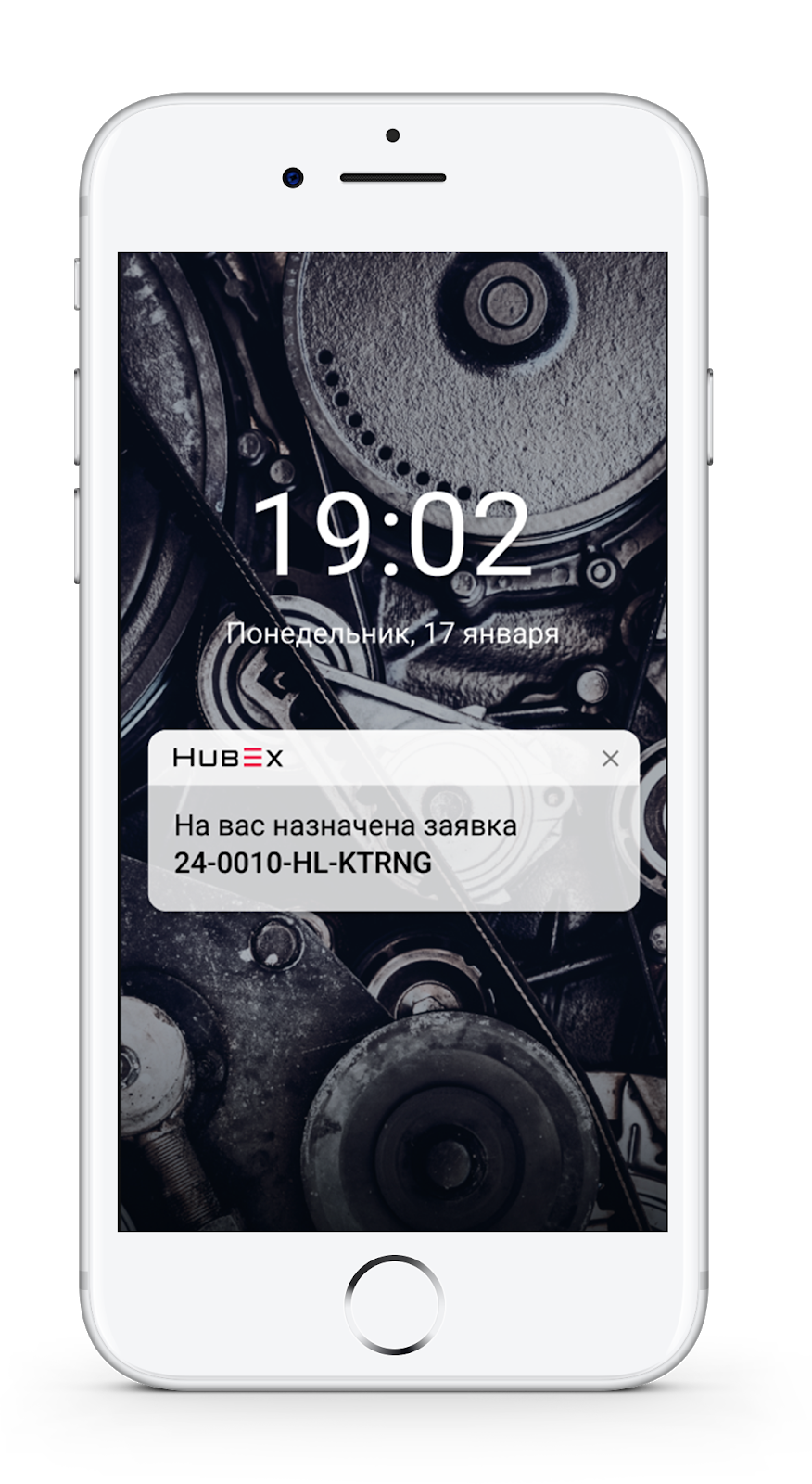
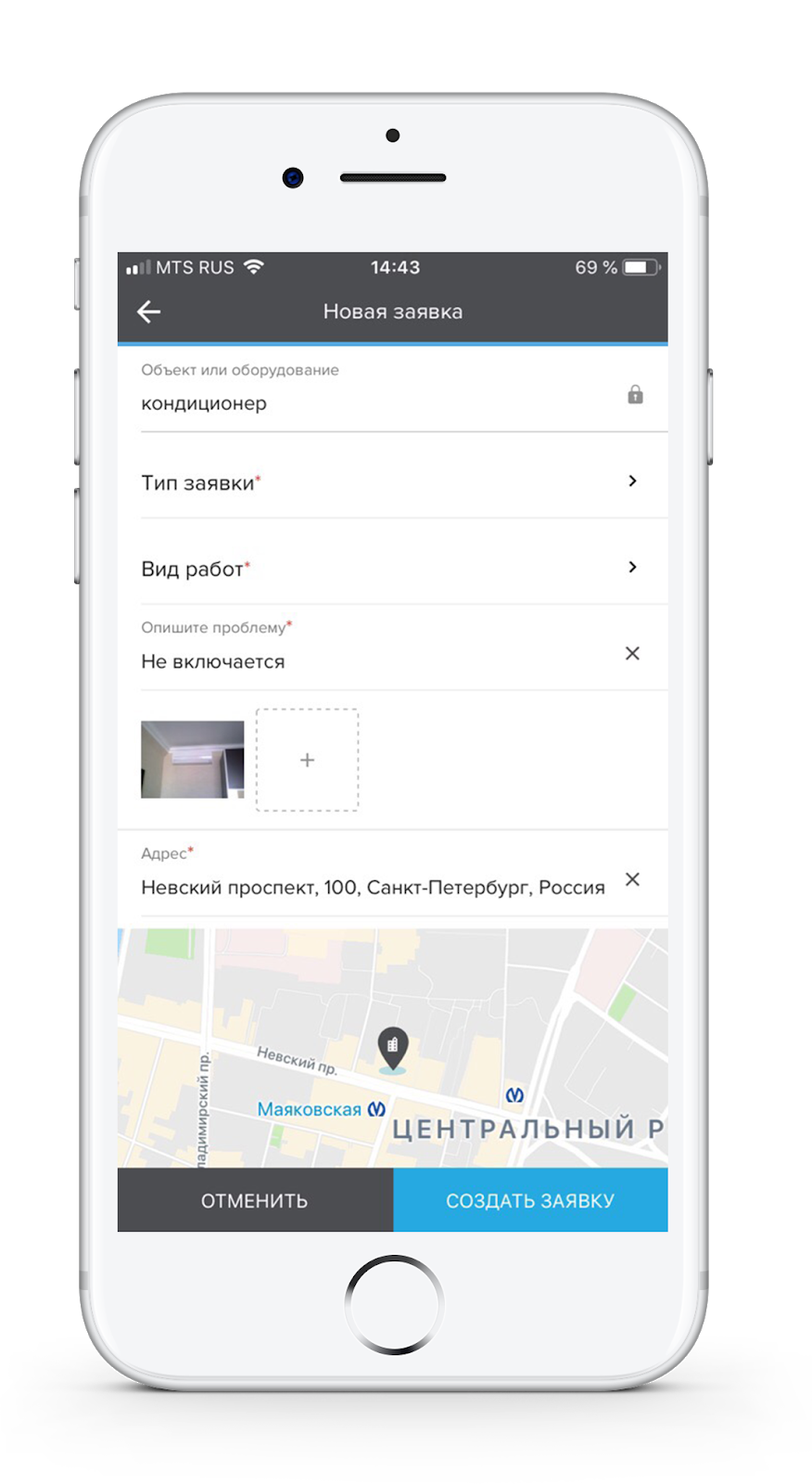
Of course, all the information immediately goes to the central base and managers or managers in the office can see all the work before the engineer or foreman returns to the workplace.
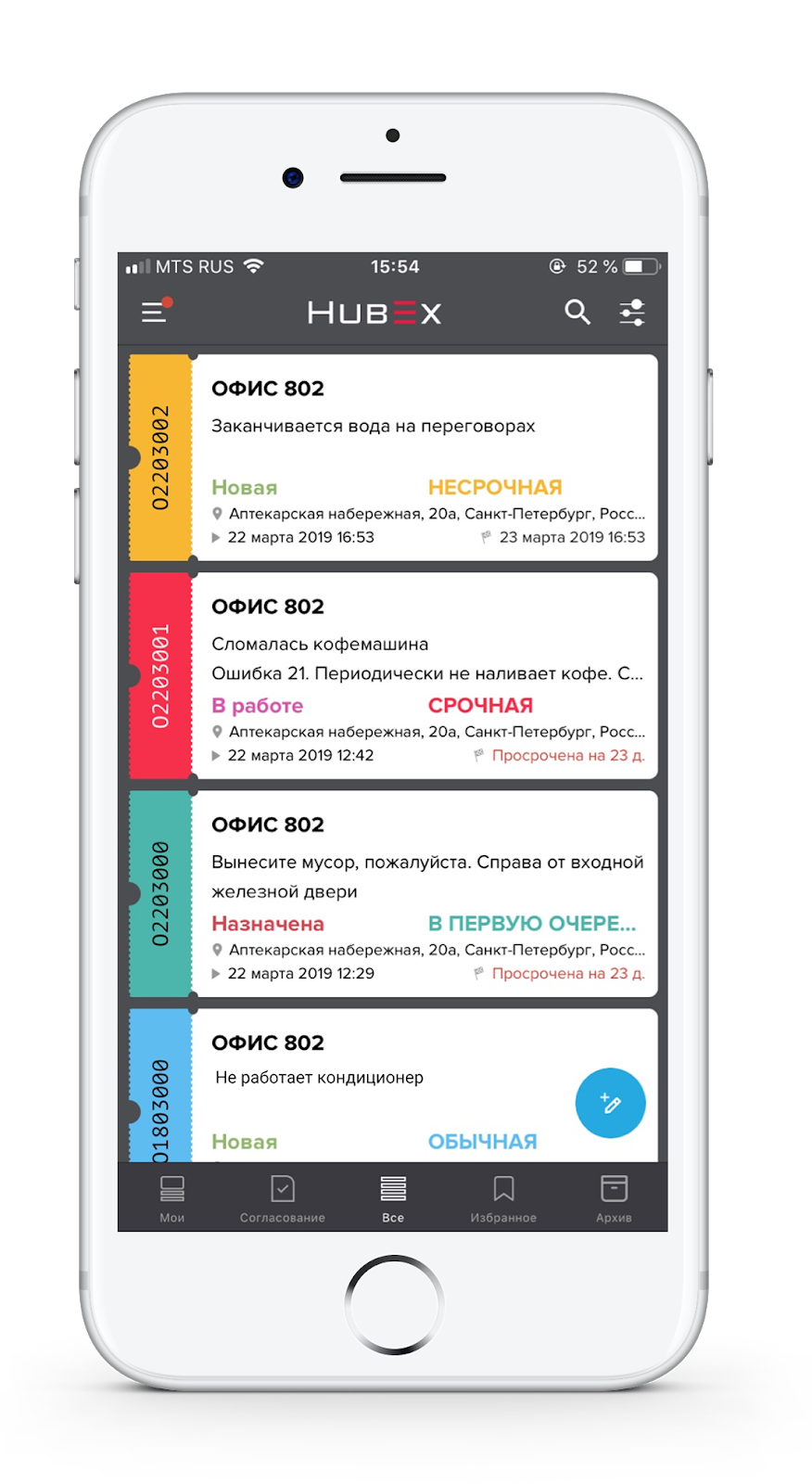
HubEx for the customer is a convenient application in which you can apply for services, attach photos and attachments to the application, monitor the repair process, communicate with the contractor, agree on the cost of work, evaluate their quality.
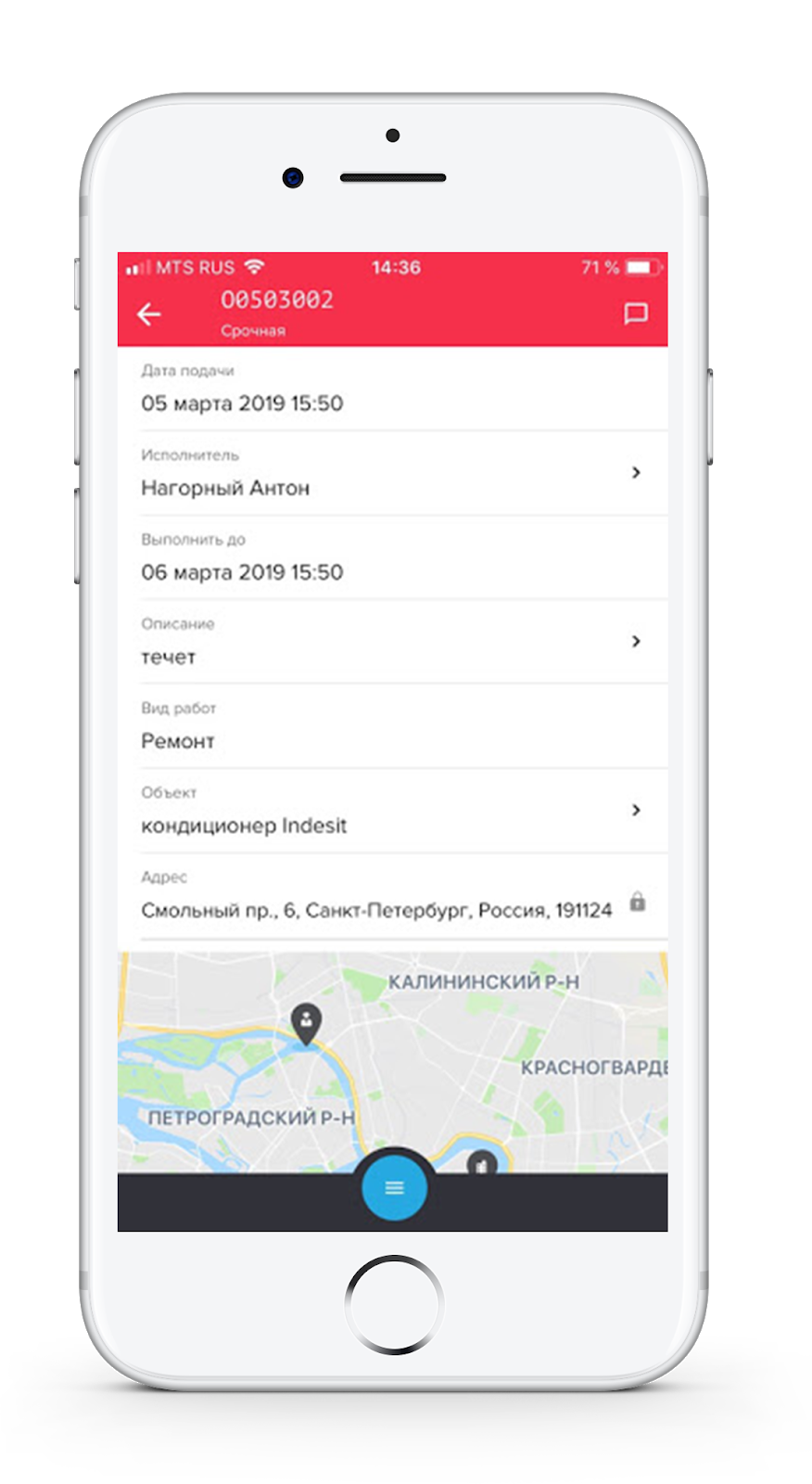
Such a two-sided implementation of a mobile application provides transparency of relations, control of work, understanding of the current point of repair at a particular point in time - thus significantly reducing the number of customer complaints and reducing the load on a call center or technical support.
Each object, each piece of equipment can be marked with a QR code generated by the HubEx system, and even with further interactions, scan the code and receive an electronic passport of the object, which contains basic information on it, relevant documents and files.

While this article was being created, we released the next release and introduced functionality that is very important from the point of view of the service department: you can track the geolocation of a mobile employee on a map and thereby track his movement route and location at a specific point. This is a tangible plus for addressing quality control issues.

As you already understood, for software of this class it is important not only to be able to accept and process applications, but also to issue employee performance metrics (after all, service engineers are more than anyone attached to KPI, which means that a complex of accurate, measurable and relevant indicators is needed). The parameters for assessing the quality of work can include, for example, the number of repeated visits, the quality of filling in applications and check lists, the correctness of movement in accordance with the route sheet, and of course, the assessment of the work performed by the customer.
In fact, HubEx is that case when it is better to look once, than to read on Habr a hundred times. In the next series of articles we will address the issues of the work of various service centers, we will analyze why the masters and employees are so angry, we will tell you what service should or should not be. By the way, if you have cool stories of fakaps or finds in the field of equipment maintenance, write in a comment or PM, we will definitely use cases and give a link to your company (if you give it a go).
We are ready for criticism, suggestions, finds and the most constructive discussion in the comments and private messages. Feedback for us is the best that can happen, because we have chosen our development vector and now we want to know how to become number one for our audience.
And if not Habr, then a cat?

Just not this one!
And also, taking this opportunity, we congratulate our leader and founder Andrei Balyakin on the winter victories of the 2018-2019 season. He is the World Champion 2015, the European Champion 2012, the four-time champion of Russia 2014 - 2017 in snowkiting and kitesurfing. Windy sports for a very serious person are the key to the success of fresh ideas in development :-) But, I think, we will talk more about this. You can read about how people from St. Petersburg win here .

Equipment service: chaos, disorder, downtime
Equipment maintenance for the majority is service centers where phones are saved from encounters with asphalt and puddles, and laptops - from tea and juice. But we are on Habré, and there are those who service equipment of all types:
- these same service centers that repair electronics and household appliances;
- printers and printing equipment service centers and outsourcers - a separate and very serious industry;
- multifunctional outsourcers - companies that service, repair and rent office equipment, electronics, etc. for office needs;
- companies providing after-sales services for industrial equipment, machinery, components and assemblies;
- business centers, management companies and their operation services;
- maintenance services at various large industrial and social facilities;
- internal business units that service the equipment in the company carry out repairs and support for internal business users.
These listed categories work in different ways, and they all know that there is an ideal scheme: incident - ticket - work - delivery and acceptance of work - closed ticket - KPI - premium (payment). But most often this chain looks like this: AAAAA! - What? - Breakdown! - What? - We can’t work, this simple one is your fault! Urgently! Important! - Pancake. We are working. - What is the status of the repair? And now? - Done, close the ticket. - Oh thank you. - Close the ticket. - And yes, I forgot. - Close the ticket.
Tired of reading, I want to test with my hands, use and criticize your service! If so, sign up for the Hubs and we are ready to work with you.
Why it happens?
- There is no equipment maintenance strategy - each case is considered haphazardly, takes time as unique, while a lot of tasks can be unified, brought under the internal corporate standard.
- No operational risk assessment. Alas, many of the company's actions are taken ex-post when repairs are needed, and in the worst case, disposal. In addition, companies often forget to take into account that there should always be a replacement fund inside technical assets - yes, these are superfluous objects in the accounting, but the costs of their purchase and maintenance can be significantly lower than the losses from a possible downtime in operating or production activities.
- No equipment management planning. A technical risk management plan is a critical aspect of working with equipment. You need to know exactly: terms of maintenance, terms of inventory and routine inspection, monitoring status, which serve as triggers for making decisions about additional actions with equipment, etc.
- The companies do not keep records of equipment, do not track the operating procedure: the input date can be tracked only by finding old documents, the service and repair history is not recorded, wear lists and the need for spare parts and assemblies are not kept.

Source . Garage Brothers do not use HubEx. But in vain!
What did we want to achieve by creating HubEx?
Of course, we do not undertake to say now that we created software that did not exist before. There are many equipment maintenance management systems, Service Desk, industry-specific ERPs, etc. on the market. We have come across similar software more than once, but we didn’t like it: the interface, the lack of a client panel, a mobile version, the use of an outdated stack and expensive DBMS. And when a developer doesn’t like something very much, he will certainly create his own. The product itself came out of a real large engineering company, i.e. we ourselves are none other than market representatives. Therefore, we know exactly the pains of service and warranty services and take them into account when developing each new product function for all business sectors.
While we are at the stage of a technological startup, and we are actively continuing to develop and develop the product, but now HubEx users can get a convenient and functional tool. But we will not refuse criticism either - that is why we came to Habr.
There are additional important tasks that HubEx can solve.
- Anticipate problems, not solve them. The software keeps records of all equipment, facts of repair and maintenance, and so on. The entity “Application” can be configured both for outsourcers and for internal technical services - you can create any stages and statuses, thanks to which you will always know exactly what state each object is in.
- To establish contact between the customer and the contractor - thanks to the messaging system, as well as the customer’s interface in HubEx, you no longer need to write hundreds of letters and answer calls, the system’s interface will contain the most detailed information.
- Supervise the repair and maintenance process: plan, schedule preventive actions, notify customers to prevent problems. (Remember how cool it is with dentists and auto centers: at some point you are reminded of the next professional examination or technical examination - you want, you don’t want, but you think about it). By the way, in the near future we plan to integrate HubEx with popular CRM-systems, which will give an impressive increase in opportunities for developing customer relationships and increasing the volume of services.
- Provide analytics that can form the basis for new business decisions and the basis of KPI for employee bonuses. You can group applications by statuses and stages, and then, based on the ratio of groups for each engineer, master or unit, calculate KPI, and also adjust the work of the company as a whole: rotate employees, conduct training, etc. (Conditionally, if Master Ivanov’s majority of applications hung up during the “troubleshooting” stage, he probably encountered unfamiliar equipment, which requires a long study of the instructions. Training is required.)
HubEx: first review
Gallop on the interface
The main advantage of our system is the constructor. In fact, we can customize the platform for each individual client for its clear tasks and it will not be repeated. In general, platforming is almost a new reality for enterprise software: the client receives a fully customized version for the cost of renting a conventional solution without the problems of scaling, configuration and management.
Another advantage is the setup of the application life cycle. Each company can set up stages and statuses of applications for each type of application in a few clicks, which will lead to the structuring of information and the generation of detailed reports. Flexible platform settings give +100 to convenience, speed and, most importantly, to transparency of actions and processes.
Inside a HubEx, a company can actually create an electronic equipment passport. You can attach any documentation to your passport, be it a file, video, picture, and so on. There you can specify the warranty period and apply FAQ with frequent problems that the equipment owners themselves can solve: this will increase loyalty and reduce the number of service calls, which will free up time for a high-quality solution to more complex problems.
To get acquainted with HubEx, it is best to leave a request on the site - we will gladly process each and help you figure it out if necessary. “Feeling” it live is quite pleasant and interesting from the point of view of the software structure: user interface, administrator interface, mobile version. But if you suddenly find it more convenient to read, we have prepared for you a brief overview of the main entities and mechanisms.
Well, if you have no time to read at all, get acquainted - HubEx, watch a compact and dynamic video about us:By the way, it’s easy to upload your data to the system: if you did your business in an Excel spreadsheet or elsewhere, then before you start working in the system, you can easily transfer them to HubEx. To do this, you need to download the Excel spreadsheet template from HubEx, fill it with your data and import it into the system - this way you can easily add the basic entities for HubEx to work and you can quickly get started. In this case, the template may be empty or include data from the system, and if incorrect data is entered, HubEx will not make an error and return a message that there is a problem with the data. Thus, you can easily overcome one of the main steps of automation - filling the automatic system with existing data.
HubEx Entities
Application is the main essence of HubEx. You can create any type of application (regular, emergency, warranty, planned, etc.), configure a template or several templates for quick application processing. Inside it, the object is set, the address of its location (with a map), the type of work, the criticality (set in the directory), the deadline, the contractor. You can add a description to the application, attach files. The application fixes the time of the start of execution and completion, thus, the responsibility of each employee becomes quite transparent. You can also set estimated labor costs and the estimated cost of work on the application.

Application Creation Form

Ability to create application stages based on company requirements

Constructor of transitions between the stages of the application, within which you can prescribe the stages, relationships, conditions. A schematic description of such a “route” is similar to the design of a business process, and can be used for a variety of purposes.
An object is attached to each application (equipment, territory, etc.). An object can be any entity that is subject to servicing by your company. When creating an object, its photo is set, attributes, files, contacts of the person responsible, types of work and check lists for specific equipment are attached. For example, if you need to diagnose a car, the checklist will include attributes listing important components, assemblies, and steps for checking and diagnosing. In the course of work, the master will check each item and will not miss anything.
By the way, you can quickly apply by scanning the QR code (if the equipment was marked by the manufacturer or service) - this is convenient, fast and as productive as possible.
The employee’s card allows you to add maximum information about the person in charge: his name, contact information, type (it is especially interesting that you can have a customer as an employee and give him access to HubEx with limited rights), company, role (with rights). In the additional tab, the qualification of the employee is added, from which it is immediately obvious what kind of work and on what objects the master or engineer can perform. Also, an employee (customer) can be banned, for which it is enough to switch the “Ban” button in the “Other” tab - after that the HubEx functions will become inaccessible for the employee. It’s a very convenient function for service providers, when a quick response to a violation can be vital for a business.

Employee passport
As we said above, in addition to the HubEx interface, you can create checklists, inside which you can write attributes - that is, items that need to be checked as part of working with each type of equipment.

Based on the results of work, a dashboard with analytics is formed inside the HubEx system, where the achieved values and indicators are displayed in the form of tables and graphs. In the dashboard, you can view statistics on the stages of applications, expiration, the number of applications by companies and individual engineers and craftsmen.

Analytical Reports
Repair, maintenance and service is not a one-time process, but a repetitive task, which, in addition to the technical function, carries a commercial burden. And, as you know, there is an unspoken law: if something happened more than two times, automate it. So we created in HubEx automatic creation of planned orders. For a ready application template, a schedule for its automatic repetition with flexible settings is set: frequency, repetition interval during the day (reminder), number of repetitions, days of the week for creating orders, etc. In fact, the setting can be any, including tied to the time before the start of work, for which it is necessary to create an application. The functionality turned out to be in demand both by service and management companies (for routine maintenance), and for companies of different groups - from cleaning and auto center to system integrators, etc. Thus, service engineers can notify the customer about the next service, and managers can sell the services.

HubEx: mobile version
Good service is not just operational or professional engineering staff, it is primarily mobility, the ability to quickly go to the client and begin to solve his problem. Therefore, without an adaptive application, by no means, but better, of course, a mobile application.
The mobile version of HubEx is two applications for the iOS and Android platforms.
HubEx for customer service is a working application for service employees in which they can create objects, keep track of equipment, see the status of work on the application, keep correspondence with dispatchers and the necessary colleagues, communicate with the customer directly, coordinate the cost of the work, evaluate their quality.
To receive and mark an object using a mobile application, just point a mobile phone at it and photograph a QR code. Then, in a convenient on-screen form, the remaining parameters are entered: the company associated with the equipment, description, photo, type, class, address and other necessary or custom attributes. Of course, this is a very convenient feature for mobile services, craftsmen and engineers on the road, outsourcing companies. Also in the application of the engineer it is visible precisely his applications and applications for approval. And of course, the program sends users push notifications with which you will not miss a single event in the system.


Of course, all the information immediately goes to the central base and managers or managers in the office can see all the work before the engineer or foreman returns to the workplace.

HubEx for the customer is a convenient application in which you can apply for services, attach photos and attachments to the application, monitor the repair process, communicate with the contractor, agree on the cost of work, evaluate their quality.

Such a two-sided implementation of a mobile application provides transparency of relations, control of work, understanding of the current point of repair at a particular point in time - thus significantly reducing the number of customer complaints and reducing the load on a call center or technical support.
HubEx Chips
Electronic equipment passport
Each object, each piece of equipment can be marked with a QR code generated by the HubEx system, and even with further interactions, scan the code and receive an electronic passport of the object, which contains basic information on it, relevant documents and files.

All employees at a glance
While this article was being created, we released the next release and introduced functionality that is very important from the point of view of the service department: you can track the geolocation of a mobile employee on a map and thereby track his movement route and location at a specific point. This is a tangible plus for addressing quality control issues.

As you already understood, for software of this class it is important not only to be able to accept and process applications, but also to issue employee performance metrics (after all, service engineers are more than anyone attached to KPI, which means that a complex of accurate, measurable and relevant indicators is needed). The parameters for assessing the quality of work can include, for example, the number of repeated visits, the quality of filling in applications and check lists, the correctness of movement in accordance with the route sheet, and of course, the assessment of the work performed by the customer.
In fact, HubEx is that case when it is better to look once, than to read on Habr a hundred times. In the next series of articles we will address the issues of the work of various service centers, we will analyze why the masters and employees are so angry, we will tell you what service should or should not be. By the way, if you have cool stories of fakaps or finds in the field of equipment maintenance, write in a comment or PM, we will definitely use cases and give a link to your company (if you give it a go).
We are ready for criticism, suggestions, finds and the most constructive discussion in the comments and private messages. Feedback for us is the best that can happen, because we have chosen our development vector and now we want to know how to become number one for our audience.
And if not Habr, then a cat?

Just not this one!
And also, taking this opportunity, we congratulate our leader and founder Andrei Balyakin on the winter victories of the 2018-2019 season. He is the World Champion 2015, the European Champion 2012, the four-time champion of Russia 2014 - 2017 in snowkiting and kitesurfing. Windy sports for a very serious person are the key to the success of fresh ideas in development :-) But, I think, we will talk more about this. You can read about how people from St. Petersburg win here .
